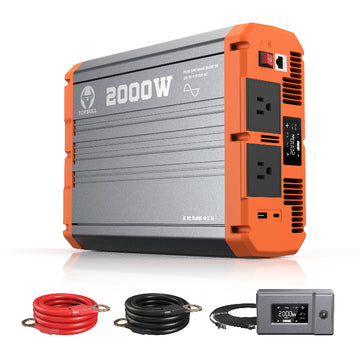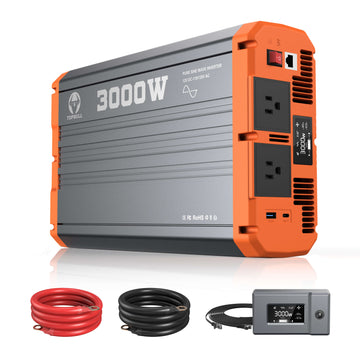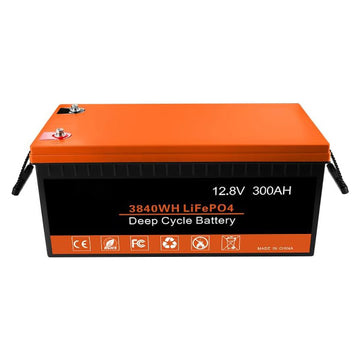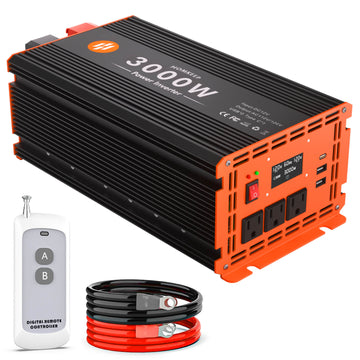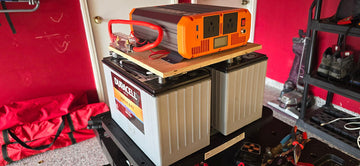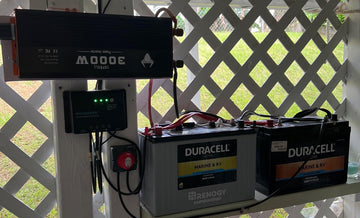Table of contents:
- How does a solar power system work
- Solar power system components
- Classification of solar power systems
- Energy Storage Methods for Solar Energy Systems
- Design factors for solar power systems
- Advantages and Disadvantages of Solar Power Systems
- Application Scenarios of Solar Power Systems
- How to buy solar power system components?
- Recommended solar power system kits
How does a solar power system work
When it comes to how a solar system works, we can break it down into a few key steps to describe it in detail:
Solar energy capture:
Solar systems capture solar energy through solar panels. A solar panel consists of multiple solar cells, each of which is a small semiconductor P-N junction.
When sunlight hits the solar panels, photons (particles of light) interact with the silicon atoms in the solar panels, creating the photovoltaic effect. This process causes electrons to detach from the silicon atoms, forming electron-hole pairs.
Electrical energy is generated:
Inside the solar cell, the two sides of the P-N junction form a potential difference due to the difference in materials. When electron-hole pairs are created, they are subjected to this potential difference, causing the electrons to move towards the N-type region and the holes to move towards the P-type region, thus generating an electric potential at both ends of the cell.
When an external circuit is turned on, electrons flow from the N-type region to the P-type region through the external circuit, forming a current. This current is the DC current generated by the solar cell.
Regulation and control of current:
In a solar system, the controller plays a vital role. It is responsible for monitoring and managing the charging process of the panels to ensure that the battery is able to store power safely and efficiently.
The controller can be set up with a variety of charging modes, such as float charging, constant current charging and constant voltage charging, in order to adapt to the needs of different battery pack types and capacities.
The controller can also set over-voltage protection, low-voltage protection, temperature compensation and other functions to ensure the stable operation of the system and the safety of the battery pack.
Storage of electrical energy:
The battery is the device used to store electrical energy in the solar system. When the solar panel produces more electrical energy than the immediate system demand, the excess electrical energy is stored in the battery.
Common types of batteries include lead-acid batteries, nickel-metal hydride batteries, and lithium batteries. Different battery types have different performance characteristics and application scenarios.
Conversion and output of electrical energy (if required):
If the solar system needs to convert DC power to AC power to meet the demand of certain equipment, it needs to be equipped with an inverter. Inverters can convert DC power into AC power that meets our daily life and industrial power needs.
The inverter can also adjust the voltage, frequency and current to suit the requirements of various electrical devices.
System integration and optimization:
Solar systems often include other components such as meters, grid connection equipment, etc. The proper installation and configuration of all these components are essential to ensure the efficient operation of solar panels.
As technology continues to advance, solar system components and configurations are being optimized. For example, by introducing intelligent control systems and advanced energy storage technologies, the energy utilization efficiency and stability of the system can be improved.
To summarize, a solar energy system works as a complex and efficient process. It captures solar energy through solar panels and converts it into electrical energy, and then realizes the storage, management and use of electrical energy through components such as controllers, batteries and inverters. This process is not only environmentally friendly and efficient, but also has great application potential and economic value.
Solar power system components
The solar power system is mainly composed of the following parts, which will be summarized and described below in a clear, point-by-point manner according to the main components of the system:
Solar Module (Solar Panel):
- It is the core part of the solar power system, responsible for converting solar energy into electricity.
- Product classification includes monocrystalline silicon solar modules, polycrystalline silicon solar modules and flexible solar modules.
- Monocrystalline silicon solar cells have the highest photoelectric conversion efficiency, usually between 15% and 24%, but at a higher cost.
- Polycrystalline silicon solar cells have a slightly lower photovoltaic conversion efficiency of about 15%.
- Flexible solar cells are bendable and suitable for special applications.
Controller:
- Controls and protects the key components of the solar power system to ensure stable operation of the system.
- Responsible for charging and discharging management of the battery to prevent overcharging and over-discharging.
Storage Battery (Group):
- Used to store the power generated by the solar modules for use at night or on cloudy and rainy days.
- Different capacities and types of batteries can be selected according to the system size and demand.
Inverter:
- If the output of AC power (e.g. 220V or 110V) is required, an inverter is needed.
- The inverter is responsible for converting the DC power generated by the solar modules into AC power.
Other auxiliary equipment:
- For distributed generation systems, this may also include equipment such as PV square array mounts, DC convergence boxes, DC distribution cabinets, and AC distribution cabinets.
- Power supply system monitoring devices and environmental monitoring devices, etc., are used to monitor the operational status of the system and environmental conditions.
Classification of solar power systems
Solar power generation system is divided into off-grid power generation system, grid-connected power generation system and distributed power generation system:
- off-grid power generation system mainly consists of solar modules, controllers, batteries, such as the output power supply for the AC 220V or 110V, but also need to configure the inverter.
- grid-connected power generation system is the solar module generated by the DC power through the grid inverter converted to meet the requirements of the utility grid AC power directly into the public power grid. Grid-connected power generation system has a centralized large-scale grid-connected power station is generally a national power station, the main feature is that the power generated by the direct transmission of energy to the grid, the grid unified deployment of power supply to the user. But this kind of power station investment, long construction period, covers a large area, has not been too much development. And decentralized small-scale grid-connected power generation system, especially photovoltaic building integrated power generation system, due to the advantages of small investment, fast construction, small footprint, policy support, etc., is the mainstream of grid-connected power generation.
- Distributed power generation system, also known as decentralized power generation or distributed energy supply, refers to the configuration of smaller PV power supply systems at or near the user site or the site of electricity consumption, in order to satisfy the needs of specific users, support the economic operation of the existing distribution grid, or to meet the requirements of these two aspects at the same time.The basic equipment of a distributed PV power generation system includes PV modules, PV square array mounts, DC convergence boxes, DC distribution cabinets, grid-connected inverters, AC distribution cabinets and other equipment, in addition to power supply system monitoring devices and environmental monitoring devices. Its mode of operation is in the conditions of solar radiation, photovoltaic power generation system of solar modules array will be converted to solar power output, through the DC convergence box centralized into the DC power distribution cabinet, by the grid-connected inverter inverter into alternating current to supply the building's own loads, excess or insufficient power through the connection to the power grid to regulate.
Energy Storage Methods for Solar Energy Systems
There are several common types of energy storage methods for solar energy systems, and these are categorized according to the form of energy conversion and storage. The following is a detailed categorization and description of these methods:
Battery Energy Storage Systems:
- Lithium-ion Battery: Lithium-ion batteries are one of the most common solar battery energy storage systems on the market today. They offer the advantages of high energy density, long life, and low self-discharge rates, and are therefore widely used in home and industrial-scale solar systems.
- Lead-acid batteries: Although lithium-ion batteries outperform lead-acid batteries in terms of efficiency and lifetime, lead-acid batteries still have a place in some applications due to their lower cost. They are typically used in smaller scale solar systems.
Compressed air energy storage systems:
- Compressed air energy storage is a method of converting electrical energy into mechanical energy for storage. In this type of system, excess electrical energy is used to drive a compressor that compresses air and stores it in a high-pressure container. When electrical energy is required, it is generated by releasing the stored compressed air to drive a turbine. This approach effectively avoids the safety issues of storage systems such as batteries and is capable of storing large amounts of energy, making it suitable for large-scale solar power scenarios.
Thermal Energy Storage:
- Concentrated Photo-Thermal: This is a method of converting solar energy into thermal energy for storage. Commonly used thermal storage methods in solar thermal systems include sensible heat storage and phase change latent heat storage. Sensible heat storage usually uses water or rock as the thermal storage medium, while phase change latent heat storage utilizes phase change media such as inorganic salts and organic fatty acids. These systems can be converted to a thermal energy supply through a heat exchanger when needed.
Other storage methods:
- Potential energy storage: these include pumped hydroelectric storage and superconducting magnetic storage. Pumped hydroelectric storage is a method of storing potential energy by pumping water from a low point to a high point and generating electricity by releasing the water when electrical energy is needed. Superconducting magnetic energy storage, on the other hand, utilizes the special properties of superconducting materials to store electrical energy.
- Kinetic energy storage: such as flywheel energy storage, etc., will be converted to the kinetic energy of the flywheel for storage, when the need for electrical energy, through the rotation of the flywheel to generate electrical energy.
Design factors for solar power systems
Design factors for solar power systems involve a variety of aspects such as geographic location and environmental conditions, system size and demand, grid connection and energy storage, system control and protection, and economic considerations. A combination of factors needs to be considered during the design process to ensure system efficiency, stability and economics. The following are some important aspects that need to be considered and evaluated:
1.Geographical location and environmental conditions
Light conditions:
- Consider the geographic location, latitude, longitude, and altitude of the installation site, which all affect solar radiation and sunlight hours.
- Understand local meteorological data, such as solar radiation intensity, cloud cover, and hours of sunshine, to assess the potential for solar power.
Temperature range:
- Consider the temperature range of the installation site, as the performance of solar panels can be affected by temperature.
- Select modules that can operate consistently in both high and low temperatures.
Wind speed and direction:
- Understand the local wind speed and direction data to design appropriate mounting and fixing methods to ensure that the solar panels are stable and reliable under wind loads.
2.System Size and Requirements
Load Demand:
- Determine the load demand and power consumption pattern of the system, including parameters such as power, voltage and current of the load.
- Design the capacity of the solar panel and the energy storage capacity of the battery pack according to the load demand.
System Expandability:
- Consider the future expansion needs of the system and choose a modular design to facilitate the addition of solar panels or battery packs when needed.
3.Grid connection and energy storage
Grid-connected access:
- If the system is designed for grid-connected power generation, it is necessary to consider the interface with the grid and the grid-connection standards to ensure that the system can be safely and stably interconnected with the grid.
Energy storage system:
- Depending on the needs of the system and the stability of the local grid, consider whether to configure an energy storage system, such as a battery pack or an energy storage plant.
- The energy storage system can balance the supply and demand of the system and improve the reliability and economy of the system.
4.System control and protection
Control system:
- Design a reasonable control system, including data acquisition, monitoring, fault alarm and other functions to ensure stable operation of the system.
Protection measures:
- Equipped with over-current, over-voltage, under-voltage, lightning and other protective measures to ensure that the system can operate safely under various abnormal conditions.
5.Economic Consideration
Initial investment:
- Consider the initial investment cost of the system, including the purchase cost of solar panels, battery packs, inverters, racking and other components, as well as installation and commissioning costs.
Operation and Maintenance Costs:
- Evaluate the operation and maintenance costs of the system, including the costs of component replacement, repair and cleaning.
Power generation benefits:
- Evaluate the power generation benefits and return on investment of the system based on local light conditions and electricity pricing policies.
Advantages and Disadvantages of Solar Power Systems
Solar power systems have a range of advantages and disadvantages, and the following is a detailed analysis of these advantages and disadvantages:
Pros:
- Renewable Energy: Solar energy is an endless and renewable source of energy. As long as the sun exists, it can constantly generate energy, so solar power systems have a long-term energy supply.
- Environmentally friendly and non-polluting: solar power systems do not produce pollutants or emit greenhouse gases during the working process, which is friendly to the environment and helps to reduce air pollution and the greenhouse effect.
- Low operating cost: Once the solar power system is installed, the operating cost is relatively low. Solar panels do not require fuel and only require regular maintenance and cleaning, resulting in low maintenance costs.
- Flexible installation: Solar power systems can be installed in a variety of locations, including rooftops, floors, deserts, mountains, etc. They can be flexibly designed and installed according to the actual situation.
- Reduced energy dependence: Solar power systems can reduce dependence on fossil fuels, increase energy security and reduce dependence on external energy supplies.
- Lower Electricity Bills: solar power systems can provide electricity to homes or businesses, reducing the need for traditional electricity and thus lowering electricity bills.
Disadvantages:
- High initial investment: solar power systems have a high initial investment cost, including the purchase cost of components such as solar panels, inverters, battery packs, and racking, as well as installation and commissioning costs.
- Affected by weather: the power generation efficiency of solar power system is affected by weather conditions, such as cloudy, rainy, night and other weather conditions, the power generation efficiency of solar panels will be reduced or even unable to generate electricity.
- Large land area: solar power systems need to occupy a certain land area to install solar panels, which may be a problem for areas with limited land resources.
- High cost of energy storage: If you need to continue to use electricity in the absence of sunlight, you need to configure an energy storage system, such as a battery bank or an energy storage power station, which will increase the cost of the system.
- Maintenance Requirements: Although solar power systems have low operating costs, they still require regular maintenance and cleaning to ensure proper system operation and power generation efficiency.
- Technology dependency: The design and installation of solar power systems require a certain level of technical knowledge and experience, and if the technology is not up to scratch, it may affect the system's performance and lifespan.
Application Scenarios of Solar Power Systems
The application scenarios of solar power systems cover a wide range of fields from household to industry and from land to sea, providing clean and renewable energy solutions for all walks of life.
1. Distributed photovoltaic power generation system:
- Application scenarios: households, enterprises, industrial parks, etc.
- Characteristics: Mainly utilizes space such as roofs and open spaces to install PV panels and provide power to users.
- Advantages: able to directly provide energy for the building, reducing the dependence on traditional energy sources and lowering the expenditure on electricity.
2. Centralized photovoltaic power station:
- Application scenario: wilderness or desert areas.
- Characteristics: Constructing large-scale PV power stations, converting solar energy into electricity through solar panels and inverters for use in the power grid.
- Advantages: Constructed in areas with abundant solar energy resources, high power generation efficiency, and large-scale power supply.
3. Photovoltaic and energy storage system:
- Application scenarios: homes, industrial parks, hospitals, etc.
- Characteristics: Combine solar panels with energy storage batteries to store electricity when power demand is low for use when power demand peaks.
- Advantages: Provides a stable power supply and reduces dependence on the power grid, especially suitable for remote areas or areas with unstable power grids.
4. Mobile photovoltaic power generation system:
- Application scenarios: field operations, oil fields, industrial parks, etc.
- Characteristics: Can be used on mobile devices to provide power for mobile devices.
- Advantages: convenient and flexible, suitable for occasions requiring mobile power.
5.PV poverty alleviation project:
- Application Scenario: Poverty-stricken areas.
- Features: Utilizes PV power generation technology to provide power to local villagers, helping to improve living conditions and promote local economic development.
- Advantages: Provide sustainable energy solutions for poor areas and promote local economic development.
6. Solar street lights:
- Application scenarios: public areas such as parks, pedestrian streets and residential areas.
- Characteristics: Charged by solar energy, automatically lit at night to provide lighting.
- Advantages: no need to connect to the grid, easy to install, energy-saving and environmentally friendly, and low operating costs.
7. Solar greenhouse:
- Application Scenario: Agricultural production.
- Features: Solar panels are installed in the greenhouse to supply electricity and regulate the temperature inside the greenhouse.
- Advantages: Utilizes solar energy to provide light and regulate temperature for plants, improving crop yield and quality.
8. Industrial applications:
- Application scenarios: industrial manufacturing, transportation, urban construction, etc.
- Features: Provide stable and reliable electricity for industrial manufacturing processes, provide energy support for charging electric vehicles and charging stations, and integrate with building facades in urban construction.
- Advantages: reduce energy costs, optimize production processes, and promote green city construction.
9. Marine field:
- Application scenarios: marine photovoltaic power generation, solar desalination, solar sea water pump heating, etc.
- Characteristics: building photovoltaic panels in the ocean, using solar energy for seawater desalination and sea water pump heating.
- Advantages: provide clean and efficient energy solutions for the marine environment.
How to buy solar power system components?
When buying solar energy system components, you can follow the steps below to ensure that you choose a product that suits your needs and is cost-effective:
Define needs and budget
Determine the needs: First of all, you need to clarify the use of their solar energy system, the required power, installation location and other key information. For example, is used for home roof power generation, industrial park power supply or field mobile power station.
Budget Planning: According to the demand, plan the budget reasonably. The price of solar system components varies according to brand, model, power and other factors, so you need to combine the actual situation to develop a budget.
Understanding the market and choosing the brand
Market research: through the network search, industry exhibitions and other ways to understand the market situation of solar energy system components, including mainstream brands, product features, price trends.
Brand selection: choose a brand with high visibility, good reputation and guaranteed quality. You can refer to industry rankings, user reviews and other information, and comprehensively consider the brand strength and service quality.
Comparison of product parameters and price
Comparison of product parameters: Compare the parameters of different brands and models of solar energy system components, such as power, conversion efficiency, size, weight, material and so on. Ensure that the selected product meets their actual needs.
Price Comparison: Combine the budget and compare the prices of different brands and models. Note that the price is not the only criterion, but also need to consider the quality of the product, after-sales service and other factors.
Recommended solar power system kits
Kits include:
- 12 x 100W Solar Panels
- 1 x 100A MPPT Solar Charge Controller
- 1 x Panel-Controller Cables
- 1 x Controller-Battery Cables
- 4 x Solar Extension Cables
- 1 x MMMMF+FFFFM Connectors
- 12 x Set of 4 Z-Brackets & Hardware
Kit Features
Efficient energy conversion: The use of high performance monocrystalline silicon solar panels is capable of achieving energy conversion efficiencies of up to 21% in bright weather conditions, ensuring maximum utilization of solar energy resources.
Independence and Reliability: The off-grid system design makes the system grid-independent and able to provide stable and reliable power support anywhere, especially in remote or off-grid areas.
Cost Reduction: In the long run, by using solar energy as a free and renewable energy source, energy costs can be significantly reduced, reducing dependence on traditional energy sources and bringing economic benefits to users.
Environmental Protection and Sustainability: Solar energy is a clean, non-polluting energy source, and the use of the system not only helps to reduce greenhouse gas emissions, but also contributes to the protection of the environment and the realization of sustainable development.
Flexibility and adaptability: The system can be flexibly configured and customized according to actual needs and site conditions, including the number of solar panels, cable length, mounting brackets, etc., to ensure that it meets the different needs of users.
Smart management and monitoring: Equipped with an intelligent charge controller and digital display, the system is able to monitor the system's operating status, charging status, battery health and other key data in real time, which is convenient for users to manage and maintain.
Easy to install and maintain: The system components are well-designed and the installation process is simple and quick, while the maintenance and upkeep are also relatively easy, which reduces the user's follow-up investment and cost.

